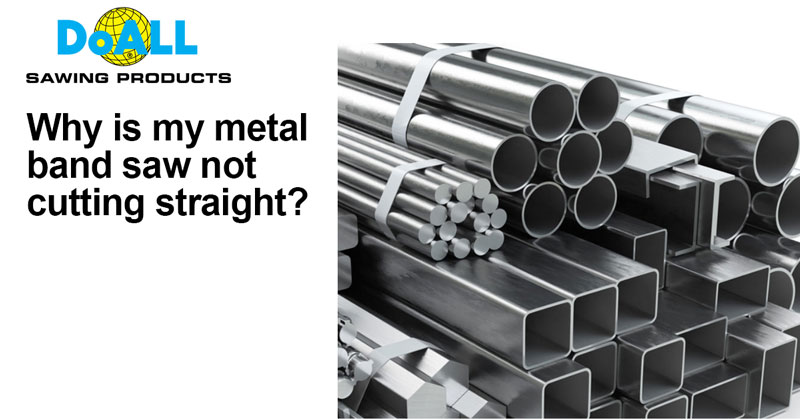8 Common Reasons Your Metal Band Saw Isn’t Cutting Straight

8 Common Reasons Your Metal Band Saw Isn’t Cutting Straight
Is your metal band saw failing to deliver straight cuts? Want to know what could be going wrong and how to fix it? You’re not alone! Your metal band saw is an essential tool in your operation, and when it fails to cut straight, it can disrupt your workflow and impact your product quality. Many metalworking professionals face challenges with band saws that don’t cut straight, impacting both efficiency and the quality of their work. At DoALL Sawing Products, we understand the importance of precision in every cut, and we're here to help you overcome these common issues.
Whether you're a seasoned machinist or just starting out, achieving flawless cuts with your metal band saw is crucial. Picture this: Your band saw effortlessly slicing through metal, delivering perfectly straight cuts every time. This isn't just a vision—it's a reality you can achieve with the right adjustments and maintenance. In this blog post, we'll explore the 8 most common reasons why your metal band saw might not be cutting straight and provide practical solutions to get you back on track. Read on to discover how you can troubleshoot and resolve these issues, ensuring your saw delivers the precision and performance you need for your projects.
- Dull Blade or Damaged Teeth: A dull blade or one with damaged teeth can cause slower cuts and out-of-tolerance results. Replacing it with a new, purpose-designed blade often solves the problem. Reach out to a DoALL Sawing Products expert for customized advice on diagnosing blade issues and choosing the best replacement.
- Blade Tension: Incorrect blade tension can result in “out of square” cuts if too loose or stress the blade if too tight. Ensure the blade is tensioned according to the manufacturer’s specifications. Check your sawing machine’s manual for recommended tension levels.
- Blade Alignment: Misaligned blades can result from worn rubber tires, wheel bearings, a damaged flange, or improper tension. Consult with a DoALL Sawing expert to address alignment issues effectively.
- Incorrect Blade Tooth Orientation: Verify that the blade is installed correctly with teeth pointed in the direction being driven by the drive wheel.
- Worn Blade Guide Inserts: Blade guide inserts are crucial for maintaining proper blade alignment at 90 degrees. Over time, these wear parts can become worn, causing the blade to “wander” and resulting in out-of-square cuts. Most band saws use guide inserts made of high-speed steel or carbide. Refer to your owner’s manual for instructions on removing and inspecting these inserts. If they appear worn or are missing, they should be replaced. Our DoALL Sawing Experts are ready to help you assess the condition of your guide inserts and ensure they are optimized for your machine.
- Blade Tracking: Proper blade tracking on your bandwheels is crucial but often overlooked. Correct tracking ensures that the back of your band is well-supported during operation. To achieve this, first identify the type of bandwheels on your saw:
- Crowned Wheels: These have a crown machined into them with no backup wheel flange. The band must run precisely along the center of this crown. This setup is commonly found on vertical saws but can also be on horizontal ones.
- Flanged Wheels: These require the band to be adjusted to ride close to the flange, which supports the band while cutting. Ensuring proper alignment of the wheels keeps the band centered within their plane and maintains the critical center of twist dimension. Any deviation in these adjustments can result in an unsupported saw band and cause out-of-square cuts.
- Cutting Fluid: Ensure your machine provides adequate coolant flow to the blade before the teeth enter the cut, throughout the cut channel, and immediately after the blade teeth exit the cut. Cutting fluids are essential not only for cooling the cutting tool but also for removing chips from the cutting channel and teeth gullets. This helps prevent chips from welding to an overheated blade, which can damage the teeth. Accumulation of chips in the gullets can cause the blade teeth to lift off the material, reducing the effective cutting area and leading to out-of-tolerance cuts, premature tooth damage, or work hardening of the material. For a thorough evaluation of your coolant setup and to optimize your cutting process, contact a DoALL Sawing Products expert. This often-overlooked aspect is critical for maintaining an efficient and precise cutting operation.
- Regularly Scheduled Machine Preventative Maintenance: Consistent upkeep, including removing chip buildup and cleaning dirt and grime, is essential for ensuring your band sawing machine operates at its best. In addition to good maintenance practices, adhering to a regular preventative maintenance schedule will significantly extend the life of your equipment. Follow your machine’s manual for tasks such as lubricating moving parts, changing oils, tightening inserts, and inspecting bearings for wear. Additionally, make sure to pump and clean the cutting fluids reservoir regularly and replace it with fresh cutting fluid. For a tailored maintenance program that ensures everything is taken care of, reach out to a DoALL Sawing Products expert. Our professional field service team is ready to handle routine maintenance, allowing you to relax knowing your equipment is in good hands.
Connect With Us:
Have questions or want to delve deeper into the world of blades crafted for businesses like yours? Don’t hesitate to reach out! We're here to answer all your queries and provide you with the specialized knowledge you need for your metalworking success. Trust DoALL, the industry leader, to provide you with the tools you need to succeed.
